The Skylake Core i3 (51W) CPU Review: i3-6320, i3-6300 and i3-6100 Tested
by Ian Cutress on August 8, 2016 9:00 AM ESTConclusion
In this review we were able to source the three 6th Generation Intel Core i3 processors with a thermal design power of 51W. These three are the main focus of the 6th Gen Core i3 range, which also features lower power T/TE parts and a reduced graphics P SKU. The Core i3 line are characterized by their design: two cores with Hyperthreading, no Turbo boost, no overclocking, support of ECC and SGX/MPX, but no support for TSX. Prices for the Core i3 processors range from $117 to $149-$157, making them an interesting choice for ~$800 gaming PC builds.
| Intel's Skylake i3 LGA1151 CPUs | ||||||||
| C/T | L3 | Base | Turbo | HD | HD Turbo | TDP | MSRP | |
| Core i3-6320 | 2/4 | 4 MB | 3.9 | - | 530 | 1150 | 51W | $149 OEM $157 box |
| Core i3-6300 | 2/4 | 4 MB | 3.8 | - | 530 | 1150 | 51W | $138 OEM $147 box |
| Core i3-6100 | 2/4 | 3 MB | 3.7 | - | 530 | 1050 | 51W | $117 |
| Core i3-6300T | 2/4 | 4 MB | 3.3 | - | 530 | 950 | 35W | $138 |
| Core i3-6100T | 2/4 | 3 MB | 3.2 | - | 530 | 950 | 35W | $117 |
| Core i3-6100TE | 2/4 | 4 MB | 2.7 | - | 530 | 1000 | 35W | $117 |
| Core i3-6098P | 2/4 | 3 MB | 3.6 | - | 510 | 1050 | 54W | $117 |
This review tested the Core i3-6320, the i3-6300 and the i3-6100. All three differ in their base frequency in a regular fashion, going from 3.9 GHz to 3.8 GHz and 3.7 GHz respectively. The Core i3-6100 also has another two adjustments: the integrated graphics also comes down by 100 MHz, and it only has 3 MB of L3 cache rather than 4 MB like the other two. This cache deficit affects several benchmarks in our test, although it is workload dependent and most of the time acts similar to another 100 Mhz CPU frequency decline. But, at $19 less than the step up to the Core i3-6300, it sits higher on the price/performance ratio.
The main competition for these processors comes from three directions.
First, Intel is its own competition - while we typically talk about people upgrading from the previous generation to the new generation, the Core i3 isn't necessarily a part that has a similar refresh cycle, but Intel still has to convince users on the 2-5 year upgrade cycle that moving from i3 to i3 is a worthy pursuit.
The next two directions come from AMD, in the form of the FX CPUs and A10 APUs. The FX-6300 and FX-8300 families of CPUs are several years old in terms of microarchitecture, but offer six and eight threads respectively at nearly similar price points (the FX-6350 is more in line with the Core i3s than the FX-8350). On the APU side, the A10-7860K and A10-7890K are both in the right price range and come with AMD's upgraded CPU cooler, which we recently reviewed and gave an award as the best bundled stock CPU cooler on the market. The APUs, while fairly newer than the FX parts, are known for their strong integrated graphics performance that easily surpasses Intel's gaming performance at this price point. It is worth noting that the older Intel CPUs and the AMD competition both use the higher powered DDR3 memory interface, while the Skylake-based Core i3 CPUs in this review are on the newer DDR4.
From our results, we can track whether the Core i3 parts have the best price/performance:

In our web tests using Chrome, Intel CPUs seem to have a significant advantage here which might be a deal breaker for users who spend a lot of time online.
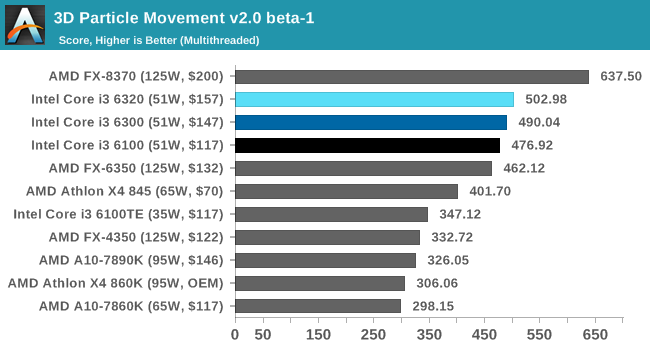
On our updated 3DPMv2 scientific benchmark, good cache management, a high IPC, and a high thread count is key to the results here. The Core i3 parts sit above the much older FX-6350 despite having two fewer threads, but AMD's latest microarchitecture in the Athlon X4 845 is close and gets a better price/performance rating.
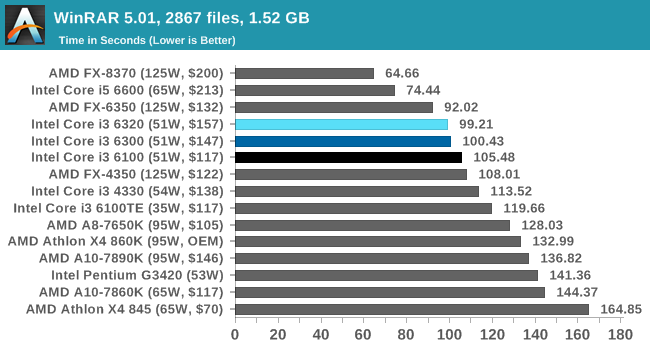
WinRAR is a variable threaded workload that requires large caches, high IPC and preferably a high frequency as well. The higher thread CPUs sit at the top here, followed closely by the set of Core i3 parts.
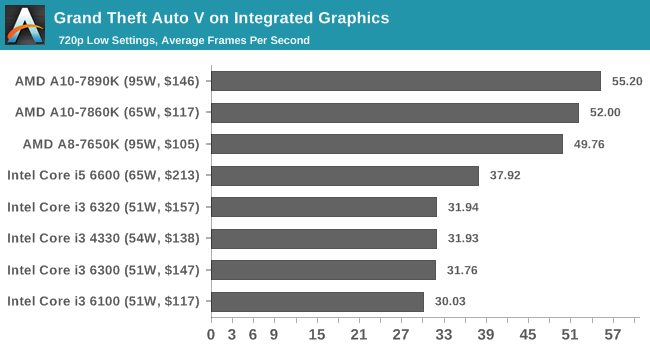
For integrated graphics, the Core i3 parts have no answer to what AMD offers at this price point. This is an important aspect, as Intel struggles to offer a part that can cope with year-old premium games at 30 FPS average at super low resolution and settings, let alone 30 FPS minimum (eSports may be a different story). The AMD parts are sole solution for premium gaming on integrated graphics at this price.
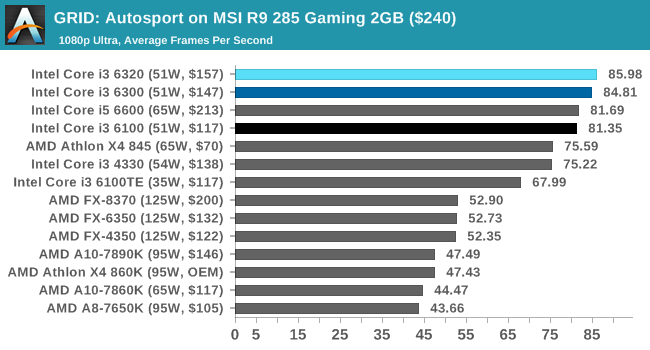
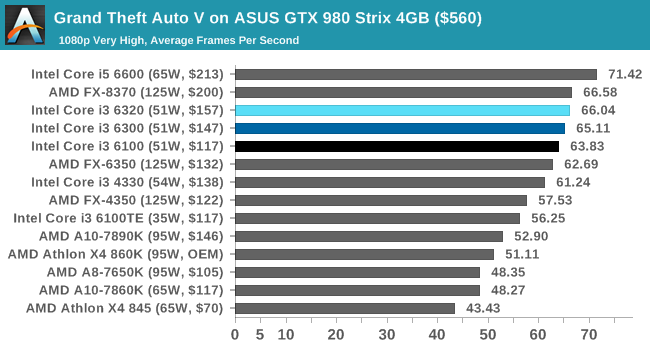
For discrete gaming, the results are particularly game and GPU dependent. In some cases, such as GRID with a mid-range AMD GPU, the Intel CPUs take the top spots with the latest Carrizo CPU from AMD coming up close behind. However, in other cases such as GTA on a high-end NVIDIA GPU, having more cache and physical cores in a modern game can push ahead of the Core i3, albeit at a higher price, and the Carrizo CPU comes in at the bottom due to its 2 MB of last-level cache.
Final Words
The Skylake Core i3 parts represent the best 'all-round' CPUs at their price. Choosing one for a system guarantees a good return in performance, and while it might not always be the best for specific applications, it's certainly near the top for almost everything. There were no circumstances where the Core i3-6100 is playing significant catchup to the other two, or that the lower cache was more of a hindrance. For ~$800 gaming builds that $30 difference between the i3-6100 and the i3-6320 could be spent elsewhere in the system. In our gaming tests the i3-6100 was only 2-4 FPS down (~5%).
Out of the three we've tested today, I would have to go for the Core i3-6100 as the processor of choice. For price and performance, the lower frequency and less cache only amounts to a 2-4% deficit at best compared to the next CPU up. The savings for 2-4% performance comes in at $30, or 20% cheaper, when we compare boxed versions.











94 Comments
View All Comments
DonMiguel85 - Monday, August 8, 2016 - link
I remember in Eurogamer's i3-6100 review, just using 2666 or 3200MHz DDR4 gave a significant performance boost in pretty much all games, especially Ryse whose maximum FPS almost doubled from 59 to over 100FPS. And this was at the stock CPU clockspeed. Minimum frames improved substantially too.wintermute000 - Monday, August 8, 2016 - link
Problem is the price premium for 3200Mhz, you're already halfway to the cost of a dGPU like a GTX950 or R460 that will blow the doors off any iGPUwintermute000 - Monday, August 8, 2016 - link
whoops I guess I was looking at the expensive stuff, realised that not all 3200 is priced that much higherbeginner99 - Tuesday, August 9, 2016 - link
exactly. If you go Skylake, buy 3200 mhz RAM. For 16 GB it's only $20-30 more than 2133 mhz RAM and totally worth it.fanofanand - Monday, August 8, 2016 - link
Fantastic article Ian, you are definitely doing a great job of filling in the "lull" period between major GPU reviews. I have been wanting exactly this review to be done, as I would love to be able to build my kid a cheap computer for school that could do a bit of light gaming. I was really hoping the APUs would give adequate performance, but it looks like I will be waiting for Zen. I really don't want to get a dGPU for his computer and with Intel it doesn't look like there is much of a choice. Zen it is! Please don't disappoint us AMD!BrokenCrayons - Tuesday, August 9, 2016 - link
I'm keenly interested in seeing what Zen brings to the table too. However my next desktop PC upgrade is going to be a GPU of some sort and even that's probably a good 6+ months away if not more. Zen will be another CPU+Mobo+RAM swap and I'm not looking forward to anything of the sort right now...unless Zen can more than double the performance of my 860K, at which point I'll be very interested.Achaios - Monday, August 8, 2016 - link
Bought a brand new laptop today with an Intel Core i5-6200U Skylake onboard (which you have failed to include in your table) clocked at 2.3 GHz which turbos to 2.8 GHz.The thing I wanna say if you try to install Windows 7 on a Skylake machine without making a little in-depth research, you're screwed.
One way to install Windows 7 on Skylake machines is described by the following ASROCK article:
http://www.asrock.com/microsite/win7install/
(Thank you ASROCK).
I am not ashamed to say I spent the better part of day fighting off the dreaded "A required CD/DVD drive device driver is missing" before I had my Windows 7 Pro 64 Bit slipstreamed and updated by ASROCK's app.
Perhaps you should consider adding a couple of words on the subject as there are many ppl who will stay on Windows 7 for several years to come and are not very familiar with the Skylake platform.
DonMiguel85 - Monday, August 8, 2016 - link
Well, of course it's not on the table - that's a mobile chip. Plus unless you have some specific business need to use Windows 7 I don't see why you would go through the hassle of putting it on there. It's an almost 7 year old OS.fanofanand - Tuesday, August 9, 2016 - link
LOL "failed to include" I love it. "I bought it so you should review it, even if it's not even in the same segment as the other products you are reviewing". Classic snowflake narcissism.Meteor2 - Tuesday, August 9, 2016 - link
1. I wish you'd calculated price/performance and power/performance for us, rather than leaving us to guesstimate2. The game benchmarks need 95th (or whatever) percentile frame rates and minimum frame times, as that's where the performance difference between i3 and i5 truly lies.